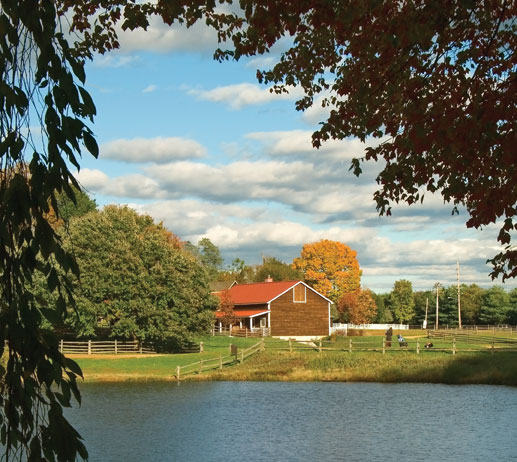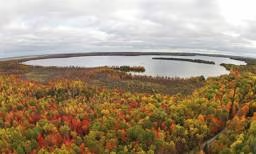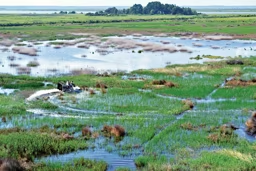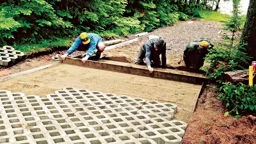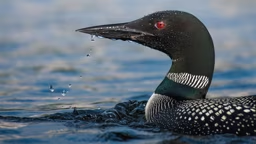What Your Lake Looks Like?
So watersheds matter because they deliver things that influence the water in a lake – which may in turn influence ducks, fish, plants, algae and sometimes our fun.
The effect can be just a matter of appearances. For example, does your lake have a coffee-color stain? The reddish-brown color is a product of decomposed peaty vegetation (that’s why the color is also referred to as a “bog stain”). The flow out of the wetland delivers stained water to your lake. The color is from organic acids which are harmless and are not pollutants. The water could even be drinkable, although it would not have the best flavor. One possible downside of bog-stained water is that it can dye a white cotton T-shirt a rusty orange color.
So watersheds matter because they deliver things that influence the water in a lake – which may in turn influence ducks, fish, plants, algae and sometimes our fun.
The effect can be just a matter of appearances. For example, does your lake have a coffee-color stain? The reddish-brown color is a product of decomposed peaty vegetation (that’s why the color is also referred to as a “bog stain”). The flow out of the wetland delivers stained water to your lake. The color is from organic acids which are harmless and are not pollutants. The water could even be drinkable, although it would not have the best flavor. One possible downside of bog-stained water is that it can dye a white cotton T-shirt a rusty orange color.
Undesirables Riding Piggyback
Watersheds can deliver substances far worse than coffee-colored water – like sediment. In fact, the world’s number one pollutant to water bodies is sediment. That’s because surface runoff in the watershed erodes and delivers millions of tons of sediments to lakes and streams every year. Some sediment in runoff is natural, but excessive sediment loads will start filling in stream channels or bays in your lake. In stream channels the sediment buildup can devastate aquatic insect habitat and fish spawning areas. In lakes, sediment buildup serves as a nutrient source for algae, smothers fish spawning sites, creates mucky bottoms, and can make some areas unusable by filling them in.
Another significant concern about sediment carried into your lake is that various substances catch piggyback rides on the sediment.
This can be the primary way phosphorus is delivered to your lake. Phosphorus in moderation is okay, but excessive phosphorus will spur nuisance algae blooms.
In watersheds, the primary phosphorous source is soil. All soils contain phosphorous, but some have more than others. For example, loamy cropland soils typically have higher phosphorous content than sandy forested soils.
In addition, when fertilizer is added to any soil type – including your lawn – it will enrich the soil with phosphorous. The problem is, by fertilizing your lawn you’re indirectly fertilizing your lake, and this pollution can lead to algae blooms.
Watersheds can deliver substances far worse than coffee-colored water – like sediment. In fact, the world’s number one pollutant to water bodies is sediment. That’s because surface runoff in the watershed erodes and delivers millions of tons of sediments to lakes and streams every year. Some sediment in runoff is natural, but excessive sediment loads will start filling in stream channels or bays in your lake. In stream channels the sediment buildup can devastate aquatic insect habitat and fish spawning areas. In lakes, sediment buildup serves as a nutrient source for algae, smothers fish spawning sites, creates mucky bottoms, and can make some areas unusable by filling them in.
Another significant concern about sediment carried into your lake is that various substances catch piggyback rides on the sediment.
This can be the primary way phosphorus is delivered to your lake. Phosphorus in moderation is okay, but excessive phosphorus will spur nuisance algae blooms.
In watersheds, the primary phosphorous source is soil. All soils contain phosphorous, but some have more than others. For example, loamy cropland soils typically have higher phosphorous content than sandy forested soils.
In addition, when fertilizer is added to any soil type – including your lawn – it will enrich the soil with phosphorous. The problem is, by fertilizing your lawn you’re indirectly fertilizing your lake, and this pollution can lead to algae blooms.
Runaway Runoff
Runoff has increased dramatically in the United States over the past 200 years. And with more runoff comes more sediments and nutrients being delivered to our lakes.
Why the increase? There are a few reasons:
1. At one time, many glacial lakes were landlocked and had small watersheds. This meant clear, clean water. But in the 1800s, lakes starting coming under development pressure, primarily for agricultural purposes. Ditches were dug to drain land for crops or grazing. The water shed area was artificially increased, increasing nutrient loads.
2. We have drained many wetlands – installing outlets so water has flowed out of these previously land-locked water bodies. Rather than infiltrating down into the ground water table, the wetland outflow is now a surface water flow.
3. As more roads, rooftops and other impervious surfaces have been built, less rain is able to soak into
the ground.
The bottom line is that with more surface runoff today, extra amounts of sediments and nutrients are being delivered to our lakes, clogging them up, encouraging algae blooms and killing off fish.
Because your lake responds to what your watershed delivers, it pays to keep an eye on what is happening in your watershed. Your children will thank you.
Steve McComas, aka the “Lake Detective,” is co-owner of Blue Water Science Consulting Company and author of “Lake and Pond Management Guidebook.”
Runoff has increased dramatically in the United States over the past 200 years. And with more runoff comes more sediments and nutrients being delivered to our lakes.
Why the increase? There are a few reasons:
1. At one time, many glacial lakes were landlocked and had small watersheds. This meant clear, clean water. But in the 1800s, lakes starting coming under development pressure, primarily for agricultural purposes. Ditches were dug to drain land for crops or grazing. The water shed area was artificially increased, increasing nutrient loads.
2. We have drained many wetlands – installing outlets so water has flowed out of these previously land-locked water bodies. Rather than infiltrating down into the ground water table, the wetland outflow is now a surface water flow.
3. As more roads, rooftops and other impervious surfaces have been built, less rain is able to soak into
the ground.
The bottom line is that with more surface runoff today, extra amounts of sediments and nutrients are being delivered to our lakes, clogging them up, encouraging algae blooms and killing off fish.
Because your lake responds to what your watershed delivers, it pays to keep an eye on what is happening in your watershed. Your children will thank you.
Steve McComas, aka the “Lake Detective,” is co-owner of Blue Water Science Consulting Company and author of “Lake and Pond Management Guidebook.”
What You Can Do?
Is there anything you can do about your watershed to improve your lake’s health? Yes! Here are five areas to consider:
• Shoreline buffer. The land that abuts your lake represents the final watershed filter. Maintaining natural vegetation along the shore serves as a natural biological, chemical and physical buffer. It even attracts wildlife – while repelling nuisance geese.
• Shoreline bump. If you live in a land of icy winters, consider leaving the shoreline bump caused by ice push. This bump will keep watershed runoff from running into the lake. Any pollutants in the runoff will soak into the ground instead.
• Unpaved areas. Are you thinking about paving your driveway? Instead, explore other options that minimize impervious surfaces and allow rainwater to penetrate the ground.
• A more natural yard. Consider leaving the fertilizer back in the city at your primary residence. Plus, if you don’t fertilize the lawn at your vacation home, you don’t have to mow as much.
• Join up. Lastly, maybe it’s time to join your local lake association.
You can voice your concerns about runoff issues and probably meet some like-minded neighbors.
Is there anything you can do about your watershed to improve your lake’s health? Yes! Here are five areas to consider:
• Shoreline buffer. The land that abuts your lake represents the final watershed filter. Maintaining natural vegetation along the shore serves as a natural biological, chemical and physical buffer. It even attracts wildlife – while repelling nuisance geese.
• Shoreline bump. If you live in a land of icy winters, consider leaving the shoreline bump caused by ice push. This bump will keep watershed runoff from running into the lake. Any pollutants in the runoff will soak into the ground instead.
• Unpaved areas. Are you thinking about paving your driveway? Instead, explore other options that minimize impervious surfaces and allow rainwater to penetrate the ground.
• A more natural yard. Consider leaving the fertilizer back in the city at your primary residence. Plus, if you don’t fertilize the lawn at your vacation home, you don’t have to mow as much.
• Join up. Lastly, maybe it’s time to join your local lake association.
You can voice your concerns about runoff issues and probably meet some like-minded neighbors.
How’s the water?” asks the guy on the dock to the swimmer in the lake.
“Wet.”
“Very funny.”
It’s an age-old smart-aleck remark. But wait a minute, have you actually thought about how water gets into a lake?
The story begins, of course, with rain and snow falling directly on the lake’s surface. But there’s more to it. There’s a whole geographic area contributing water to a lake, and it’s called a watershed. Watersheds also are referred to as catchment areas or drainage basins.
“So what?” asks our smart- aleck friend on the dock.
So … watersheds are critical to the health of lakes – because what’s in your watershed ends up in your lake. We’re not just talking about water, but whatever is carried in that water, which may include harmful things like massive amounts of sediment, and fertilizers – which contain phosphorous. Phosphorous stimulates algae growth, and let’s face it, nobody likes too much algae.
What about sediment? Pollutants bind to sediments, and thereby catch a ride on sediments that are carried into your lake. Excessive sediments bring in excessive nutrients, producing – you guessed it – excessive algae.
All this algae contributes to oxygen depletion when the algae die. Oxygen depletion is not good for plant or animal habitats and can even produce fish kills.
“Wet.”
“Very funny.”
It’s an age-old smart-aleck remark. But wait a minute, have you actually thought about how water gets into a lake?
The story begins, of course, with rain and snow falling directly on the lake’s surface. But there’s more to it. There’s a whole geographic area contributing water to a lake, and it’s called a watershed. Watersheds also are referred to as catchment areas or drainage basins.
“So what?” asks our smart- aleck friend on the dock.
So … watersheds are critical to the health of lakes – because what’s in your watershed ends up in your lake. We’re not just talking about water, but whatever is carried in that water, which may include harmful things like massive amounts of sediment, and fertilizers – which contain phosphorous. Phosphorous stimulates algae growth, and let’s face it, nobody likes too much algae.
What about sediment? Pollutants bind to sediments, and thereby catch a ride on sediments that are carried into your lake. Excessive sediments bring in excessive nutrients, producing – you guessed it – excessive algae.
All this algae contributes to oxygen depletion when the algae die. Oxygen depletion is not good for plant or animal habitats and can even produce fish kills.
How Big Is Your Watershed?
At many lakes, you can stand on your dock and view the surrounding ridgeline. That is more than likely your watershed boundary. If you can see the ridgeline, it represents a relatively small drainage area – probably a few square miles. Precipitation that falls on the hillside slopes will run into your lake, whereas precipitation that falls on the other side of the ridge line flows to another body of water and to a different watershed.
But looks can be deceiving. If there is a stream running through a gap in that ridgeline, that stream is delivering water to your lake from another watershed. Your watershed may be a lot bigger than it first appeared.
Why the geology and geography lessons? Knowing the size of your watershed and knowing a little about your local geology and geography influences how to maintain your lake if it’s healthy, or how to fix your lake if it’s ailing.
At many lakes, you can stand on your dock and view the surrounding ridgeline. That is more than likely your watershed boundary. If you can see the ridgeline, it represents a relatively small drainage area – probably a few square miles. Precipitation that falls on the hillside slopes will run into your lake, whereas precipitation that falls on the other side of the ridge line flows to another body of water and to a different watershed.
But looks can be deceiving. If there is a stream running through a gap in that ridgeline, that stream is delivering water to your lake from another watershed. Your watershed may be a lot bigger than it first appeared.
Why the geology and geography lessons? Knowing the size of your watershed and knowing a little about your local geology and geography influences how to maintain your lake if it’s healthy, or how to fix your lake if it’s ailing.
Fertilizing the Lake
To a farmer or gardener, there’s nothing better than the sight, smell and feel of good black dirt.
To a lakehome owner, there’s nothing better than the sight of clear, clean water. If your cabin is on a clear water lake – that is, you can see down 10 or 20 feet into the water – the water is that clear because it is not very productive. That means it doesn’t produce a lot of open water plants or, in this case, algae.
If your watershed has the kind of fertile topsoil that makes farmers and gardeners happy, it’s vital to control excessive sediment erosion. Why? Because fertile soils contain a lot of nutrients that will basically fertilize your lake and make you and your neighboring cabin owners unhappy.
You can think of a clear water lake as being like a desert when it comes to plant production (versus a corn field or even a forest). One way to describe production is to look at the annual yield of plant material per acre, per year:
• 2 tons – What a clear water lake might yield (in this case, we’re talking about algae). That’s about the same amount of plant material produced by a desert ecosystem.
• 6-7 tons – What a formerly clear water lake might yield during a severe algae bloom condition – meaning you’ll be looking at a pea-green-soup condition.
• 20 tons – What a grassland in fertile soils might yield.
So the challenge is to keep your lake like a desert, and to stop it from resembling a grassland.
To a farmer or gardener, there’s nothing better than the sight, smell and feel of good black dirt.
To a lakehome owner, there’s nothing better than the sight of clear, clean water. If your cabin is on a clear water lake – that is, you can see down 10 or 20 feet into the water – the water is that clear because it is not very productive. That means it doesn’t produce a lot of open water plants or, in this case, algae.
If your watershed has the kind of fertile topsoil that makes farmers and gardeners happy, it’s vital to control excessive sediment erosion. Why? Because fertile soils contain a lot of nutrients that will basically fertilize your lake and make you and your neighboring cabin owners unhappy.
You can think of a clear water lake as being like a desert when it comes to plant production (versus a corn field or even a forest). One way to describe production is to look at the annual yield of plant material per acre, per year:
• 2 tons – What a clear water lake might yield (in this case, we’re talking about algae). That’s about the same amount of plant material produced by a desert ecosystem.
• 6-7 tons – What a formerly clear water lake might yield during a severe algae bloom condition – meaning you’ll be looking at a pea-green-soup condition.
• 20 tons – What a grassland in fertile soils might yield.
So the challenge is to keep your lake like a desert, and to stop it from resembling a grassland.

 © Maxim Amelin | Agency: Dreamstime
© Maxim Amelin | Agency: Dreamstime  © Robert Brown | Agency: Dreamstime.com
© Robert Brown | Agency: Dreamstime.com 